Assessment of the Resilience of a Tartary Buckwheat (Fagopyrum tataricum) Cultivation System in Meigu, Southwest China
Abstract
1. Introduction
2. Materials and Methods
2.1. Study Sites
2.2. Method of the Study
2.3. Data Analysis
3. Results
3.1. Definition of the System
3.2. Agroecosystem Network Structure
3.3. The Resilience of the Socio-Ecological Production Landscapes and Seascapes (SEPLS) in the Tartary Buckwheat Cultivation System in Meigu County
3.3.1. The Ecological Resilience of SEPLS
3.3.2. The Agricultural Resilience of SEPLS
3.3.3. The Social Resilience of SEPLS
3.3.4. The Overall Resilience of SEPLS
4. Discussion
5. Conclusions
Author Contributions
Funding
Acknowledgments
Conflicts of Interest
References
- Altieri, M.A.; Koohafkan, P. Globally important ingenious agricultural heritage systems (GIAHS): Extent, significance, and implications for development. In Proceedings of the Second International Workshop and Committee Meeting for the Globally Important Agricultural Heritage Systems (GIAHS) Project, Buenos Aires, Argentina, 21–23 October 2009; FAO: Rome, Italy. Available online: http://www.fao.org/3/ap021e/ap021e.pdf (accessed on 15 December 2019).
- Moguel, P.; Toledo, V.M. Biodiversity conservation in traditional coffee system of Mexico. Conserv. Biol. 1999, 13, 11–21. [Google Scholar] [CrossRef]
- Vandermeer, J. Tropical Agroecosystems; CRC Press: Boca Raton, FL, USA, 2003; p. 194. [Google Scholar]
- Estrada, A.; Raboy, B.; Oliveira, L.C. Agroecosystems and primate conservation in the tropics: A review. Am. J. Primatol. 2012, 1–16. [Google Scholar] [CrossRef]
- Holasova, M.; Fiedlerova, V.; Smrcinova, H.; Orsak, M.; Lamchman, J.; Vavreinova, S. Buckwheat—the source of antioxidant activity in function foods. Food Res. Int. 2002, 35, 207–211. [Google Scholar] [CrossRef]
- Bisht, I.S.; Mehta, P.S.; Bhandari, D.C. Traditional crop diversity and its conservation on-farm for sustainable agricultural production in Kumaon Himalaya of Uttaranchal state: A case study. Genet. Resour. Crop Evol. 2007, 54, 345–357. [Google Scholar] [CrossRef]
- Huang, W.J.; Jarvis, D.I.; Ahmed, S.; Long, C.L. Tartary buckwheat genetic diversity in the Himalayas associated with farmer landrace diversity and low dietary dependence. Sustainability 2017, 9, 1806. [Google Scholar] [CrossRef]
- Ohnishi, O. Discovery of new Fagopyrum species and its implication for the studies of evolution of Fagopyrum and of the origin of cultivated buckwheat. In Current Advances in Buckwheat Research; Matano, T., Ujihara, A., Eds.; Shinshu University Press: Nagano, Japan, 2016; Volume I–III, pp. 175–190. [Google Scholar]
- Jones, M.K.; Liu, X.Y. Origins of agriculture in East Asia. Science 2009, 324, 730. [Google Scholar] [CrossRef] [PubMed]
- Jarvis, D.I. Pollen evidence of changing Holocene monsoon climate in Sichuan Province, China. Quat. Res. 1993, 39, 325–337. [Google Scholar] [CrossRef]
- Plieninger, T.; Bieling, C. Connecting cultural landscapes to resilience. In Resilience and the Cultural Landscape: Understanding Change in Human-shaped Environments; Plieninger, T., Bieling, C., Eds.; Cambridge University Press: Cambridge, UK, 2012; pp. 3–26. [Google Scholar]
- Ciftcioglu, G.C. Assessment of the resilience of socio-ecological production landscapes and seascapes: A case study from Lefke Region of North Cyprus. Ecol. Indic. 2017, 73, 128–138. [Google Scholar] [CrossRef]
- Cabell, J.F.; Oelofse, M. An indicator framework for assessing agroecosystem resilience. Ecol. Soc. 2012, 17, 18. [Google Scholar] [CrossRef]
- Walker, B.; Meyers, J.A. Thresholds in ecological and social? ecological systems: A developing database. Ecol. Soc. 2004, 9, 3. [Google Scholar] [CrossRef]
- Unnasch, R.S.; Braun, D.P.; Comer, P.J.; Eckert, G.E. The Ecological Integrity Assessment Framework: A Framework for Assessing the Ecological Integrity of Biological and Ecological Resources of the National Park System Report to the National Park Service. 2018. Available online: https://www.natureserve.org/fr/node/161 (accessed on 16 December 2019).
- UNU-IAS United Nations University Institute of Advanced Studies. Indicators of resilience in socio-ecological landscapes (SEPLs). UNU-IAS Policy Report (Authors: Bergamini, N.; Blasiak, R.; Eyzaguirre; Ichikawa, K.; Mijatovic, D.; Nakao, F.; Subramanian, S.M.). 2013. Available online: http://archive.ias.unu.edu/resource.centre/Indicators-of-resilience-in-sepls.ev.pdf (accessed on 11 November 2019).
- Berkes, F.; Colding, J.; Folke, C. (Eds.) Navigating Social-Ecological Systems: Building Resilience for Complexity and Change; Cambridge University Press: New York, NY, USA, 2003. [Google Scholar]
- Wheatbelt, NRM Inc. Natural resource management incorporated 2013 resilience. Strateg. Rev. 2013. Available online: http://www.wheatbeltnrm.org.au/ (accessed on 15 October 2019).
- Matthews, R. The people and landscape model (PALM): Towards full integration of human decision-making and biophysical simulation models. Ecol. Model. 2006, 194, 329–343. [Google Scholar] [CrossRef]
- Gallopiín, G.C. Linkages between vulnerability, resilience, and adaptive capacity. Global Environ. Chang. 2006, 16, 293–303. [Google Scholar] [CrossRef]
- Charette-Castonguay, A. Assessment of Resilience and Adaptability of Social-Ecological Systems: A Case Study of the Banaue Rice Terraces. Master’s Thesis, Institute for Natural Resource Conservation, Kiel University, Kiel, Germany, 2014. [Google Scholar]
- Ratnadass, A.; Fernandes, P.; Avelino, J.; Habib, R. Plant species diversity for sustainable management of crop pests and diseases in agroecosystems: A review. Agron. Sustain. Dev. 2012, 32, 273–303. [Google Scholar] [CrossRef]
- Pretty, J.; Bharcha, Z.P. Sustainable intensification in agricultural systems. Ann. Bot. 2014, 114, 1571–1596. [Google Scholar] [CrossRef]
- Jackson, W. Natural systems agriculture: A truly radical alternative. Agr. Ecosyst. Environ. 2002, 88, 111–117. [Google Scholar] [CrossRef]
- Song, Y.; Fang, Q.; Jarvis, D.I.; Bai, K.; Liu, D.; Feng, J.; Long, C.L. Network analysis of seed flow, a traditional method for conserving Tartary buckwheat (Fagopyrum tataricum) landraces in Liangshan, Southwest China. Sustainability 2019, 11, 4263. [Google Scholar] [CrossRef]
- Yang, Y.; Bai, K.; Li, G.; Jarvis, D.; Long, C.L. Assessment of the resilience in SEPLS (Social- Ecological Production Landscapes and Seascapes) in Yanuo Village, Xishuangbanna, Southwest China. Sustainability 2020, 12, 3774. [Google Scholar] [CrossRef]
- Alexiades, M.N.; Sheldon, J.W. Selected Guidelines for Ethnobotanical Research: A Field Manual; New York Botanical Garden: New York, NY, USA, 1996. [Google Scholar]
- Borgatti, S.; Everett, M.; Freeman, L. UciNet Visualization; Analytic Technologies: Lexington, KY, USA, 2012. [Google Scholar]
- Thebault, E.; Fontaine, C. Stability of ecological communities and the architecture of mutualistic and trophic networks. Science 2010, 329, 853–856. [Google Scholar] [CrossRef] [PubMed]
- Allesina, S.; Tang, S. Stability criteria for complex ecosystems. Nature 2012, 483, 205–208. [Google Scholar] [CrossRef]
- James, A.; Pitchford, J.W.; Plank, M.J. Disentangling nestedness from models of ecological complexity. Nature 2012, 487, 227–230. [Google Scholar] [CrossRef]
- Thompson, R.M.; Brose, U.; Dunne, J.A.; Hall, R.O.; Hladyz, S.; Kitching, R.L.; Martinez, N.D.; Rantala, H.; Romanuk, T.N.; Stouffer, D.B.; et al. Food webs: Reconciling the structure and function of biodiversity. Trends Ecol. Evol. 2012, 27, 689–697. [Google Scholar] [CrossRef] [PubMed]
- Power, A.G. Ecosystem services and agriculture: Tradeoffs and synergies. Philos. T. R. Soc. B. 2010, 365, 2959–2971. [Google Scholar] [CrossRef] [PubMed]
- Kremen, C.; Miles, A.F. Ecosystem services in biologically diversified versus conventional farming systems: Benefits, externalities, and trade-offs. Ecol. Soc. 2012, 17, 40. [Google Scholar] [CrossRef]
- Moss, B. Water pollution by agriculture. Philos. T. R. Soc. B. 2008, 363, 659–666. [Google Scholar] [CrossRef] [PubMed]
- Potts, S.G.; Biesmeijer, J.C.; Kremen, C.; Nermann, P.; Schweiger, O.; Kunin, W.E. Global pollinator declines: Trends, impacts and drivers. Trends Ecol. Evol. 2010, 25, 345–353. [Google Scholar] [CrossRef] [PubMed]
- Matson, P.A. Agricultural intensification and ecosystem properties. Science 1997, 277, 504–509. [Google Scholar] [CrossRef]
- Bommarco, R.; Kleijn, D.; Potts, S.G. Ecological intensification: Harnessing ecosystem services for food security. Trends Ecol. Evol. 2013, 28, 230–238. [Google Scholar] [CrossRef]
- Pei, S.J. Traditional culture and biodiversity conservation. Bull. Chin. Acad. Sci. 2010, 2, 190–196. (In Chinese) [Google Scholar]
- Haddad, N.M.; Crutsinger, G.M.; Gross, K.; Haarstad, J.; Tilman, D. Plant diversity and the stability of foodwebs. Ecol. Lett. 2011, 14, 42–46. [Google Scholar] [CrossRef]
- Loreau, M.; Mazancourt, C.D. Biodiversity and ecosystem stability: A synthesis of underlying mechanisms. Ecol. Lett. 2013, 16 (Suppl. 1), 106–115. [Google Scholar] [CrossRef]
- Tilman, D.; Reich, P.B.; Knops, J.M. Biodiversity and ecosystem stability in a decade-long grassland experiment. Nature 2006, 441, 629–632. [Google Scholar] [CrossRef] [PubMed]
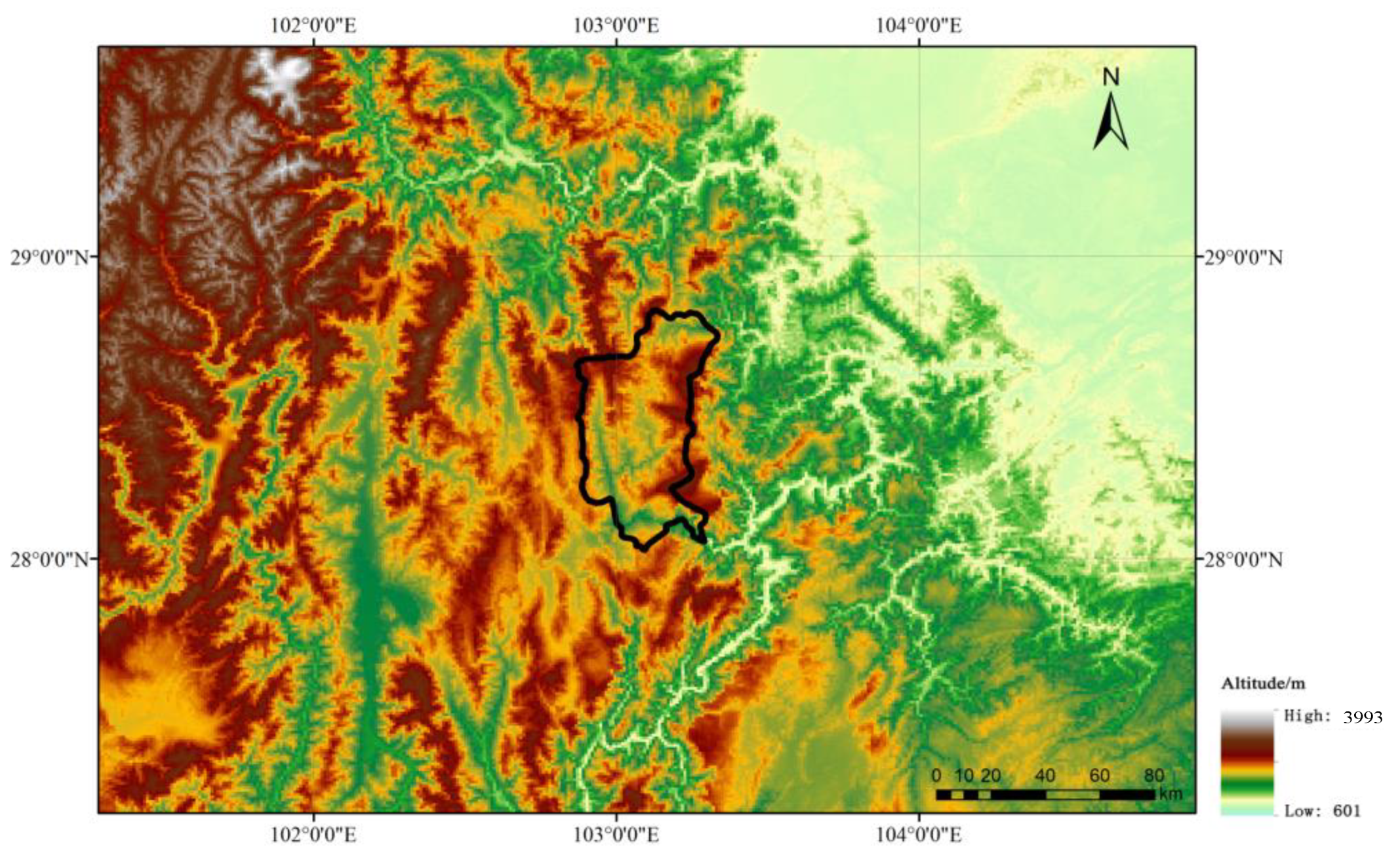
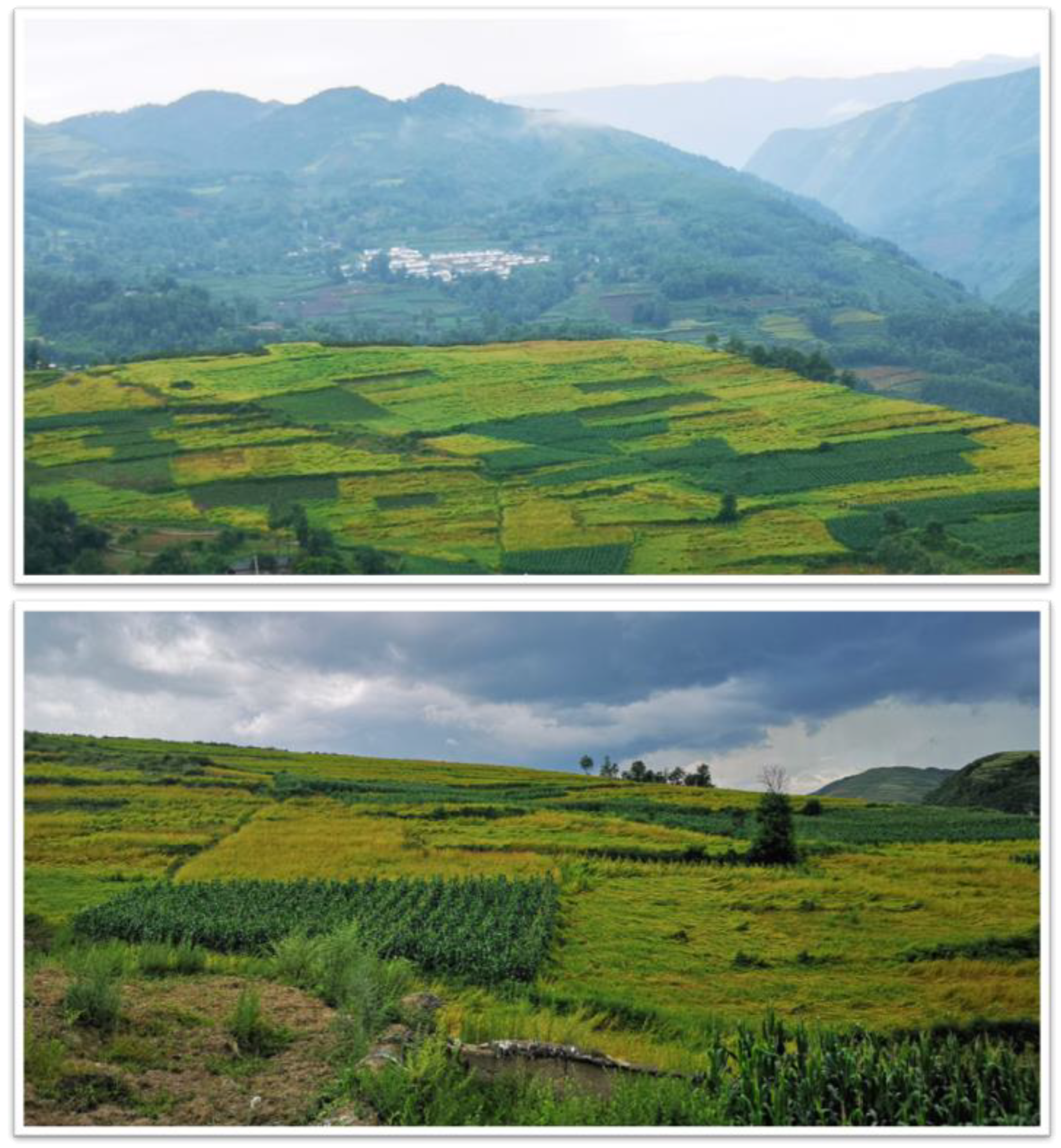
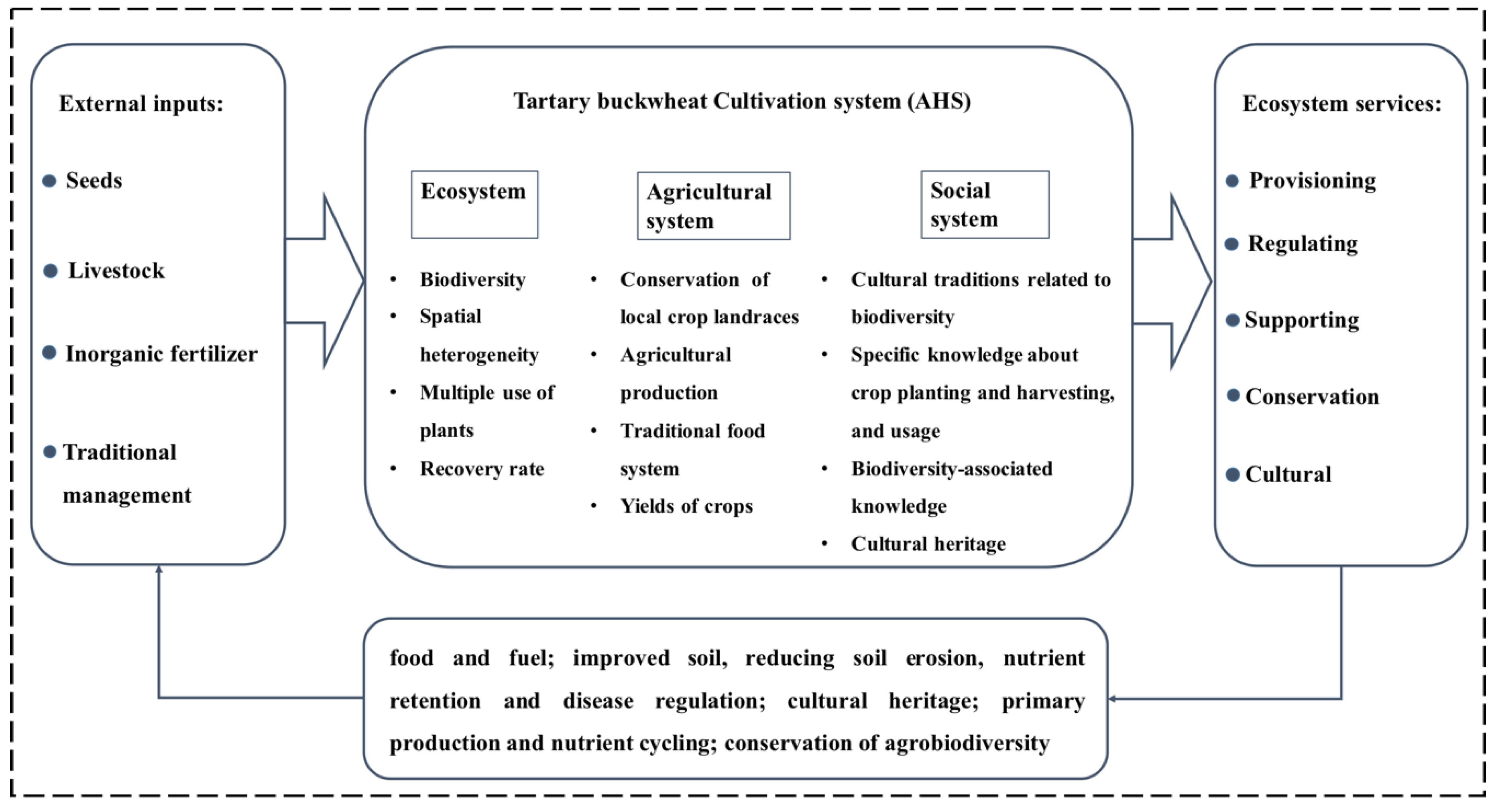
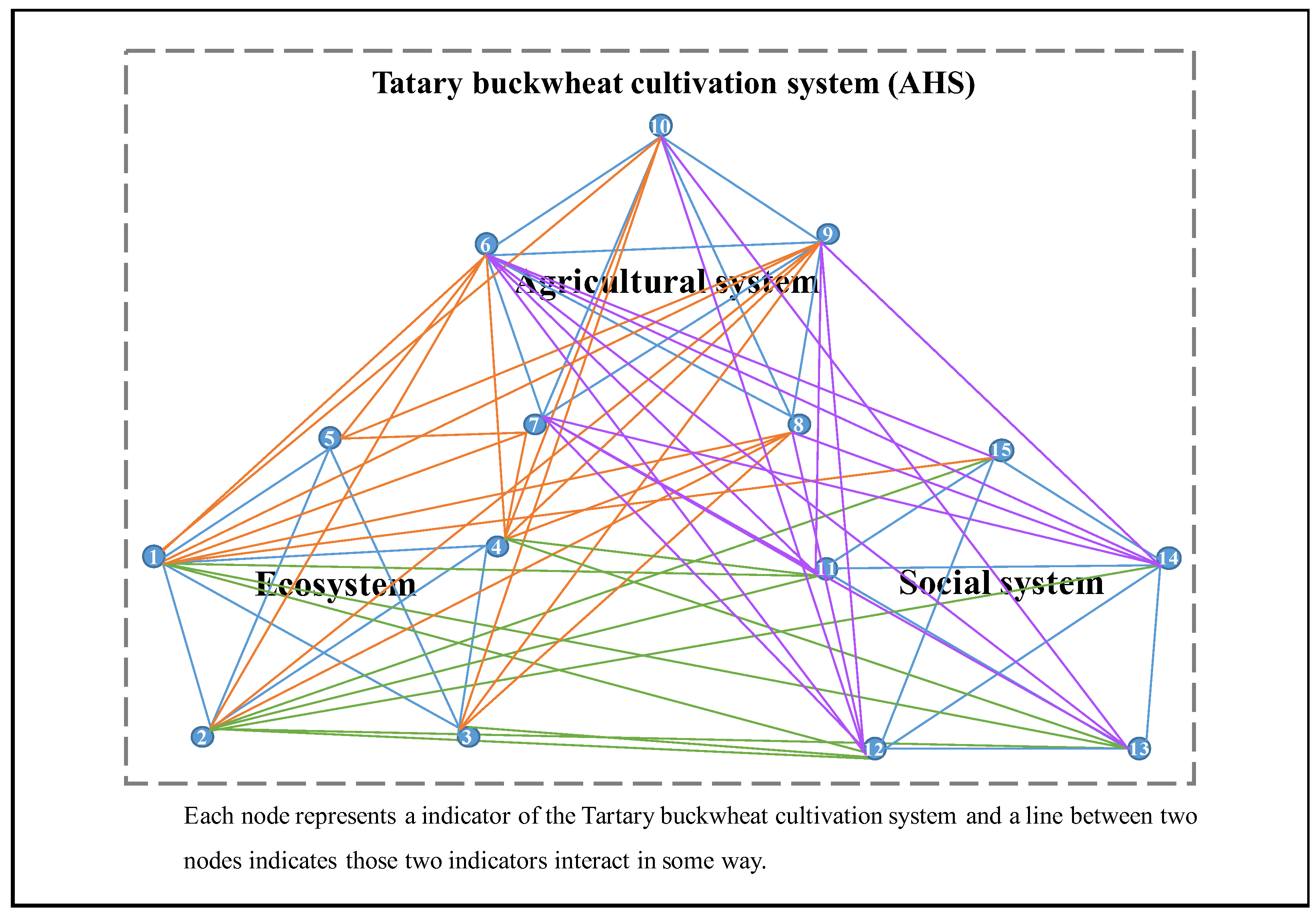
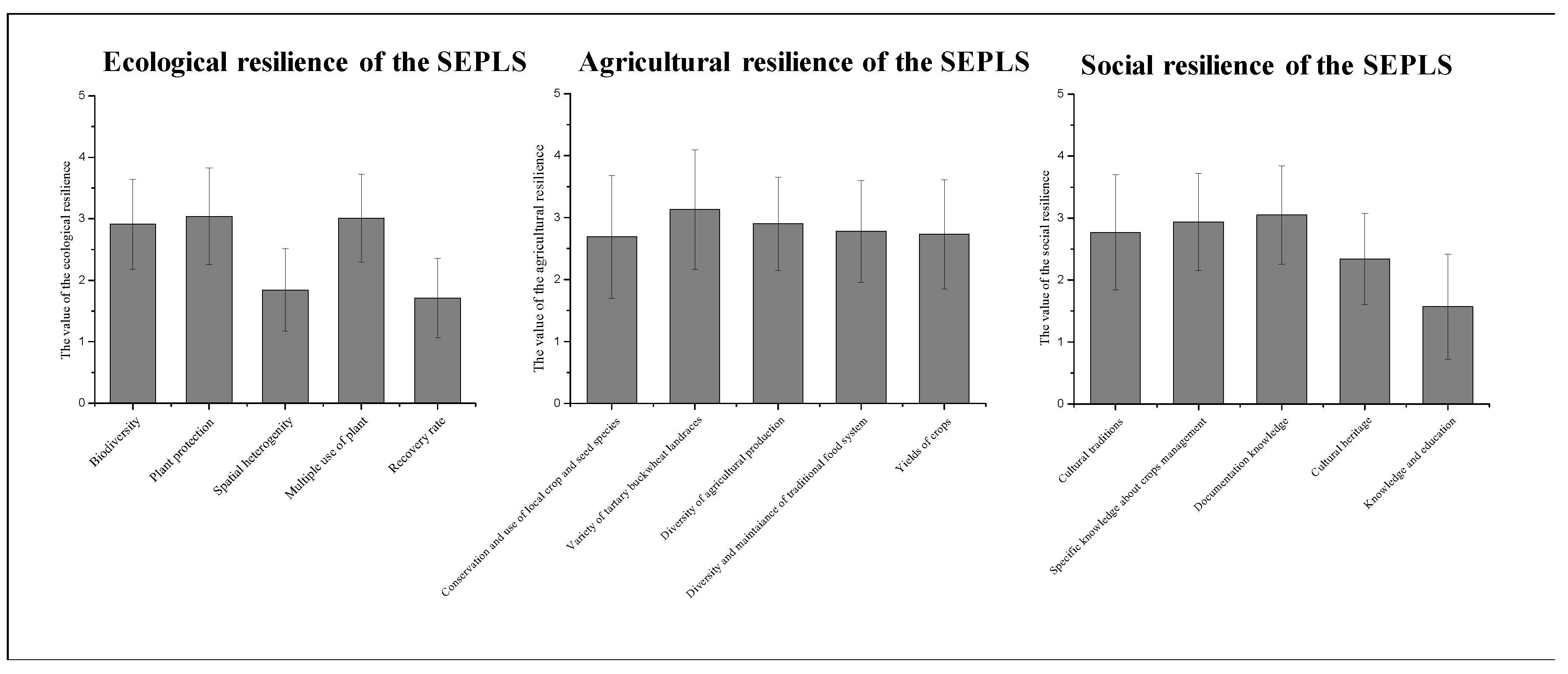
| Category of Population Profile | Characteristics of the Population Profile | Number of Respondents | Percentage of Respondents (%) |
|---|---|---|---|
| Gender | Male | 33 | 42.9 |
| Female | 44 | 57.1 | |
| Age range | 10–29 | 14 | 18.2 |
| 30–39 | 15 | 19.5 | |
| 40–49 | 22 | 28.5 | |
| 50–59 | 12 | 15.6 | |
| 60–90 | 14 | 18.2 | |
| Education level | Illiterate | 52 | 67.5 |
| Primary school | 14 | 18.2 | |
| Middle school | 7 | 9.0 | |
| High school | 3 | 3.9 | |
| University | 1 | 1.3 | |
| Outing experience | No outing experience | 60 | 77.9 |
| Migrant working | 17 | 22.1 |
| Type of System | Principle | Indicators |
|---|---|---|
| Ecosystem | Biodiversity | 1. Degree of variety in biodiversity |
| Plant protection for their ecological importance | 2. Degree of plant protection | |
| Spatial heterogeneity | 3. Degree of land use rate | |
| Multiple use of plants | 4. Number of plant species harvested from land | |
| Recovery rate from extreme environmental stresses | 5. Degree of recovery rate | |
| Agricultural system | Conservation and use of local agriculture crop species and seeds | 6. Degree of conservation of landraces |
| Variety of Tartary buckwheat landraces | 7. Degree of Tartary buckwheat landraces | |
| Diversity of agricultural production | 8. Degree of agricultural production | |
| Diversity and maintenance of traditional food system | 9. Degree of production use of local sources | |
| Yields of crops | 10. Degree of crops yields | |
| Social system | Cultural traditions related to biodiversity | 11. Degree of rituals & festival used plant |
| Specific knowledge about crop planting and harvesting, and usage | 12. Degree of knowledge of management and usage about crops | |
| Documentation of biodiversity-associated knowledge | 13. Degree of seed exchange network | |
| Cultural heritage | 14. Degree of translating knowledge from elder to young people | |
| Knowledge and education | 15. Degree of education quality |
| Indicators | Degree Centrality |
|---|---|
| Degree of variety in biodiversity | 14.39 |
| Degree of plant protection | 12.70 |
| Degree of land use rate | 12.70 |
| Number of plant species harvested from land | 11.85 |
| Degree of recovery rate | 8.47 |
| Degree of conservation of landraces | 14.39 |
| Degree of Tartary buckwheat landraces | 11.00 |
| Degree of agricultural production | 11.00 |
| Degree of production use of local sources | 13.55 |
| Degree of crops yields | 11.00 |
| Degree of rituals & festival used plant | 11.00 |
| Degree of knowledge of management and usage about crops | 13.55 |
| Degree of seed exchange network | 11.00 |
| Degree of translating knowledge from elder to young people | 11.00 |
| Degree of education quality | 8.47 |
| Density | 1.40 |
| Type of System | Indicators | Mean Score (1–5 Point) |
|---|---|---|
| Ecosystem | Degree of variety in biodiversity | 2.91 ± 0.73 |
| Degree of plant protection | 3.04 ± 0.79 | |
| Degree of land use rate | 1.84 ± 0.67 | |
| Number of plant species harvested from land | 3.01 ± 0.72 | |
| Degree of recovery rate | 1.71 ± 0.65 | |
| Agricultural system | Degree of conservation of landraces | 2.69 ± 0.99 |
| Degree of Tartary buckwheat landraces | 3.13 ± 0.97 | |
| Degree of agricultural production | 2.90 ± 0.75 | |
| Degree of production use of local sources | 2.78 ± 0.82 | |
| Degree of crops yields | 2.73 ± 0.88 | |
| Social system | Degree of rituals & festival used plant | 2.77 ± 0.93 |
| Degree of knowledge of management and usage about crops | 2.94 ± 0.78 | |
| Degree of seed exchange network | 3.05 ± 0.79 | |
| Degree of translating knowledge from elder to young people | 2.34 ± 0.74 | |
| Degree of education quality | 1.57 ± 0.85 |
© 2020 by the authors. Licensee MDPI, Basel, Switzerland. This article is an open access article distributed under the terms and conditions of the Creative Commons Attribution (CC BY) license (http://creativecommons.org/licenses/by/4.0/).
Share and Cite
Song, Y.; Jarvis, D.I.; Bai, K.; Feng, J.; Long, C. Assessment of the Resilience of a Tartary Buckwheat (Fagopyrum tataricum) Cultivation System in Meigu, Southwest China. Sustainability 2020, 12, 5683. https://doi.org/10.3390/su12145683
Song Y, Jarvis DI, Bai K, Feng J, Long C. Assessment of the Resilience of a Tartary Buckwheat (Fagopyrum tataricum) Cultivation System in Meigu, Southwest China. Sustainability. 2020; 12(14):5683. https://doi.org/10.3390/su12145683
Chicago/Turabian StyleSong, Yingjie, Devra I. Jarvis, Keyu Bai, Jinchao Feng, and Chunlin Long. 2020. "Assessment of the Resilience of a Tartary Buckwheat (Fagopyrum tataricum) Cultivation System in Meigu, Southwest China" Sustainability 12, no. 14: 5683. https://doi.org/10.3390/su12145683
APA StyleSong, Y., Jarvis, D. I., Bai, K., Feng, J., & Long, C. (2020). Assessment of the Resilience of a Tartary Buckwheat (Fagopyrum tataricum) Cultivation System in Meigu, Southwest China. Sustainability, 12(14), 5683. https://doi.org/10.3390/su12145683






